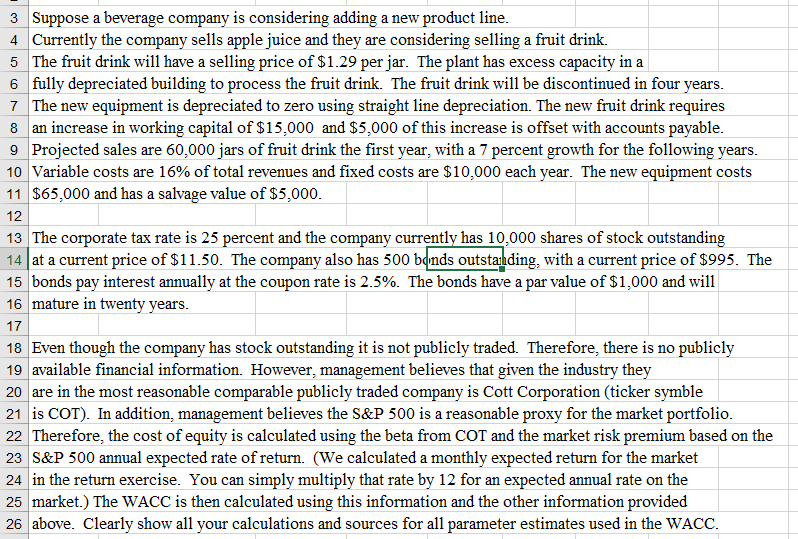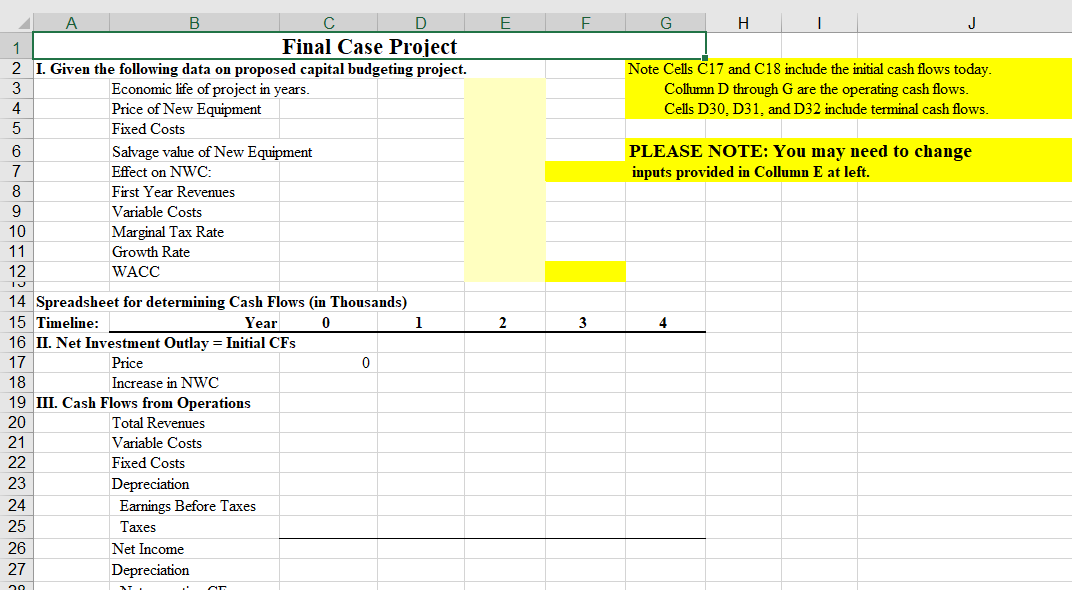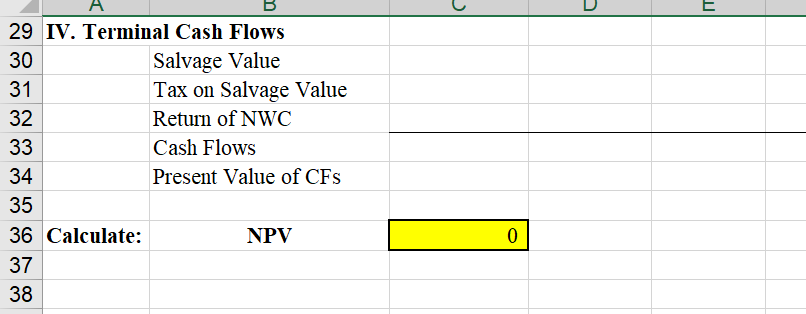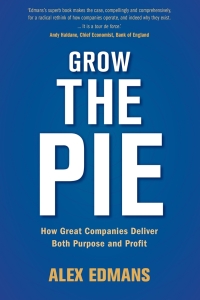




3 Suppose a beverage company is considering adding a new product line. 4 Currently the company sells apple juice and they are considering selling a fruit drink. 5 The fruit drink will have a selling price of $1.29 per jar. The plant has excess capacity in a 6 fully depreciated building to process the fruit drink. The fruit drink will be discontinued in four years. 7 The new equipment is depreciated to zero using straight line depreciation. The new fruit drink requires 8 an increase in working capital of $15,000 and $5,000 of this increase is offset with accounts payable. 9 Projected sales are 60,000 jars of fruit drink the first year, with a 7 percent growth for the following years. 10 Variable costs are 16% of total revenues and fixed costs are $10,000 each year. The new equipment costs 11 $65,000 and has a salvage value of $5,000. 12 13 The corporate tax rate is 25 percent and the company currently has 10,000 shares of stock outstanding 14 at a current price of $11.50. The company also has 500 bands outstanding, with a current price of $995. The 15 bonds pay interest annually at the coupon rate is 2.5%. The bonds have a par value of $1,000 and will 16 mature in twenty years. 17 18 Even though the company has stock outstanding it is not publicly traded. Therefore, there is no publicly 19 available financial information. However, management believes that given the industry they 20 are in the most reasonable comparable publicly traded company is Cott Corporation (ticker symble 21 is COT). In addition, management believes the S&P 500 is a reasonable proxy for the market portfolio. 22 Therefore, the cost of equity is calculated using the beta from COT and the market risk premium based on the 23 S&P 500 annual expected rate of return. (We calculated a monthly expected return for the market 24 in the return exercise. You can simply multiply that rate by 12 for an expected annual rate on the 25 market.) The WACC is then calculated using this information and the other information provided 26 above. Clearly show all your calculations and sources for all parameter estimates used in the WACC. 28 Required 29 1. Calculate the WACC for the company. 30 2. Create a partial income statement incremental cash flows from this project in the 31 Blank Template worksheet using the tab below. 32 3. Enter formulas to calculate the NPV by finding the PV of the cash flows over the next four years. 33 (You can either use the EXCEL formula PVO) or use mathmatical formula for PV of a lump sum.) 34 4. Set up the EXCEL worksheet so that you are able to change the parameters in E3 to E12. 35 Run three cases best, most likely, and worst case where the growth rate is 30%, 20%, and 5%, 36 respectfully. 37 5. Create a NPV profile for the most likely case scenario. (See NPV Calculation tab below.) 38 6. State whether the company should accept or reject the project for each case scenario. E F G H 1 Note Cells C17 and C18 include the initial cash flows today. Collumn D through G are the operating cash flows. Cells D30, D31, and D32 include terminal cash flows. PLEASE NOTE: You may need to change inputs provided in Collumn E at left. B 1 Final Case Project 2 I. Given the following data on proposed capital budgeting project. 3 Economic life of project in years. 4 Price of New Equipment 5 Fixed Costs 6 Salvage value of New Equipment 7 Effect on NWC: 8 First Year Revenues 9 Variable Costs 10 Marginal Tax Rate 11 Growth Rate 12 WACC 14 Spreadsheet for determining Cash Flows (in Thousands) 15 Timeline: Year 0 1 16 II. Net Investment Outlay = Initial CFs 17 Price 0 18 Increase in NWC 19 III. Cash Flows from Operations 20 Total Revenues 21 Variable Costs 22 Fixed Costs 23 Depreciation 24 Earnings Before Taxes 25 Taxes 26 Net Income 27 Depreciation 2 3 4 29 IV. Terminal Cash Flows 30 Salvage Value 31 Tax on Salvage Value 32 Return of NWC 33 Cash Flows 34 Present Value of CFS 35 36 Calculate: NPV 37 38 0 B D E F G H 1 J K L M N O Q R. S A 1. Creating a NPV Profile 2 Discount Rate: 0% 2% 3 Year CF PVCF) PV(CF) 0 Create a NPV by creating a line graph of rows 9 and 10. You may want to use different discount rates in your NPV profile 4% 6% PV(CF) PV(CF) 8% PV(CF) 4 Cells B4 to B8 in this worksheet can link to cells C32 to G32 in the Blank Template worksheet. 5 1 Find the present value of cash flows by referencing row 2 for the discount rate. You can do column C the same way as you did C33 to G33 in the Blank Template worksheet. Rows 9 & 10 are the table that are used to crate the NPV profile graph. 0% 6 2 7 3 8 4 9 NPV 10 Discount Rate: 11 12 13 14 15 16 2% 4% 6% 8% 3 Suppose a beverage company is considering adding a new product line. 4 Currently the company sells apple juice and they are considering selling a fruit drink. 5 The fruit drink will have a selling price of $1.29 per jar. The plant has excess capacity in a 6 fully depreciated building to process the fruit drink. The fruit drink will be discontinued in four years. 7 The new equipment is depreciated to zero using straight line depreciation. The new fruit drink requires 8 an increase in working capital of $15,000 and $5,000 of this increase is offset with accounts payable. 9 Projected sales are 60,000 jars of fruit drink the first year, with a 7 percent growth for the following years. 10 Variable costs are 16% of total revenues and fixed costs are $10,000 each year. The new equipment costs 11 $65,000 and has a salvage value of $5,000. 12 13 The corporate tax rate is 25 percent and the company currently has 10,000 shares of stock outstanding 14 at a current price of $11.50. The company also has 500 bands outstanding, with a current price of $995. The 15 bonds pay interest annually at the coupon rate is 2.5%. The bonds have a par value of $1,000 and will 16 mature in twenty years. 17 18 Even though the company has stock outstanding it is not publicly traded. Therefore, there is no publicly 19 available financial information. However, management believes that given the industry they 20 are in the most reasonable comparable publicly traded company is Cott Corporation (ticker symble 21 is COT). In addition, management believes the S&P 500 is a reasonable proxy for the market portfolio. 22 Therefore, the cost of equity is calculated using the beta from COT and the market risk premium based on the 23 S&P 500 annual expected rate of return. (We calculated a monthly expected return for the market 24 in the return exercise. You can simply multiply that rate by 12 for an expected annual rate on the 25 market.) The WACC is then calculated using this information and the other information provided 26 above. Clearly show all your calculations and sources for all parameter estimates used in the WACC. 28 Required 29 1. Calculate the WACC for the company. 30 2. Create a partial income statement incremental cash flows from this project in the 31 Blank Template worksheet using the tab below. 32 3. Enter formulas to calculate the NPV by finding the PV of the cash flows over the next four years. 33 (You can either use the EXCEL formula PVO) or use mathmatical formula for PV of a lump sum.) 34 4. Set up the EXCEL worksheet so that you are able to change the parameters in E3 to E12. 35 Run three cases best, most likely, and worst case where the growth rate is 30%, 20%, and 5%, 36 respectfully. 37 5. Create a NPV profile for the most likely case scenario. (See NPV Calculation tab below.) 38 6. State whether the company should accept or reject the project for each case scenario. E F G H 1 Note Cells C17 and C18 include the initial cash flows today. Collumn D through G are the operating cash flows. Cells D30, D31, and D32 include terminal cash flows. PLEASE NOTE: You may need to change inputs provided in Collumn E at left. B 1 Final Case Project 2 I. Given the following data on proposed capital budgeting project. 3 Economic life of project in years. 4 Price of New Equipment 5 Fixed Costs 6 Salvage value of New Equipment 7 Effect on NWC: 8 First Year Revenues 9 Variable Costs 10 Marginal Tax Rate 11 Growth Rate 12 WACC 14 Spreadsheet for determining Cash Flows (in Thousands) 15 Timeline: Year 0 1 16 II. Net Investment Outlay = Initial CFs 17 Price 0 18 Increase in NWC 19 III. Cash Flows from Operations 20 Total Revenues 21 Variable Costs 22 Fixed Costs 23 Depreciation 24 Earnings Before Taxes 25 Taxes 26 Net Income 27 Depreciation 2 3 4 29 IV. Terminal Cash Flows 30 Salvage Value 31 Tax on Salvage Value 32 Return of NWC 33 Cash Flows 34 Present Value of CFS 35 36 Calculate: NPV 37 38 0 B D E F G H 1 J K L M N O Q R. S A 1. Creating a NPV Profile 2 Discount Rate: 0% 2% 3 Year CF PVCF) PV(CF) 0 Create a NPV by creating a line graph of rows 9 and 10. You may want to use different discount rates in your NPV profile 4% 6% PV(CF) PV(CF) 8% PV(CF) 4 Cells B4 to B8 in this worksheet can link to cells C32 to G32 in the Blank Template worksheet. 5 1 Find the present value of cash flows by referencing row 2 for the discount rate. You can do column C the same way as you did C33 to G33 in the Blank Template worksheet. Rows 9 & 10 are the table that are used to crate the NPV profile graph. 0% 6 2 7 3 8 4 9 NPV 10 Discount Rate: 11 12 13 14 15 16 2% 4% 6% 8%











